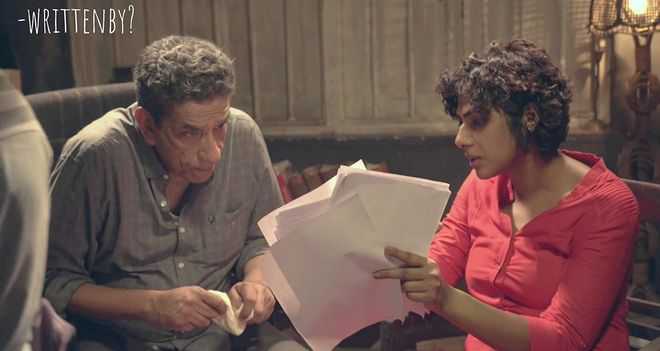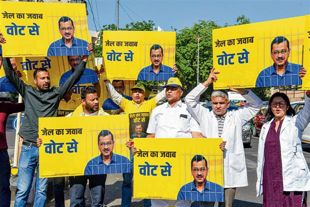
Written By?
Shoma A. Chatterji
Kankana Chakraborty’s short film Written By? has been winning awards left, right and centre. Through a poignantly well-told story with two characters — one an out-of-work-once-famous-film director and scriptwriter, and the other, his young intern, the director makes a scathing attack on plagiarism in cinema. The director says her film is inspired by her friends and colleagues who were forever complaining about their ideas, concepts, stories and scripts being mercilessly “stolen” by others. Sabyasachi Chakrabarty and Kankana, who play the two lead characters, have just been bestowed with the Best Actor Duo Award at the Los Angeles Top Shorts recently. The film makes no bones about attacking plagiarism in cinema.
Is ‘remake’ a euphemism for plagiarisation? Imitation? Inspiration? Adaptation? Interpretation? Obsession with a foreign theme? At what point does ‘inspiration’ end and plagiarism begin? While the term ‘remake’ generally connotes the complete remaking of an earlier film, crossing barriers of geography, language and culture, the connotation has evolved over time to embrace shots, scenes, images, music, songs, soundtrack and the works.
Mansoor Ali Khan’s Akele Hum Akele Tum was a melodramatic remake of the Dustin Hoffman-starrer Kramer v/s Kramer. But no one was talking then. Plagiarism occurs when a writer duplicates another writer’s language or ideas and then calls the work his or her own.
The list is endless. Murder took a stab at Unfaithful, and Munnabhai MBBS was within a heartbeat of Patch Adams. Hollywood films that have been milked include Fatal Attraction (Jurm) and Analyze This (Hum Kisise Kum Nahin). The stale, oft-repeated and oft-seen story of the Ajay Devgn-Priyanka Chopra-starrer Blackmail is a masala mix of Ransom, Cape Fear, A Perfect World and Dhoom with John Woo also getting a nod in the action sequences. Mahesh Manjrekar’s Rakht generously borrowed chunks from The Gift, Eyes of Laura Mars and The Sixth Sense. Hum Tum is a take-off on When Harry Met Sally while Bunty Aur Babli is known for its spoof on Bonnie and Clyde.
One of the most intelligent and successful plagiarised film in the history of Hindi cinema is Ramesh Sippy’s iconic film Sholay. According to several studies, this film has “borrowed” from some famous international classics which, it may be satirically said that “copying from one source is plagiarism, copying from several sources is research. But research implies the researchers citing their sources which Sippy did not. Yet, the film remains an example of how to make an all-time classic that every section of the audience loves just by “copying” from here and there.
Letty Mariam Abraham writes: “The Magnificent Seven directed by John Sturges, originally ‘inspired’ by the Japanese film Seven Samurai, which revolves around seven men brought in from different parts of the world to save a village from the clutches of a bandit group. Though Sholay had only two men, they were brought to Ramgadh with the same purpose.” Akira Kurosawa’s Seven Samurai (1954) was nominated for the Oscar in two categories. Sam Pekingpah’s classic The Wild Bunch (1969) has a mind-blowing scene of loot in a moving train. We see a similar scene in Sholay where Sippy even follows the slow motion original shootouts. Butch Cassidy and the Sundance Kid was another source of “inspiration” for the train sequence and also, for substituting Jai and Veeru for the two expert robbers in the original. Spencer Trace had only one arm which unfolded only in the end of the film because he tucked his jacket sleeve in it. Sanjeev Kumar wrapped a shawl to hide his severed arms.
Essential to an act of plagiarism is an element of dishonesty in attempting to pass off the plagiarised work as original. Plagiarism is not necessarily the same as copyright infringement which occurs when one violates the copyright law. But if there is a frame-to-frame ‘lift’, the producer/director of the ‘original’ might sue the ‘remake’ maker.
The term ‘remake’ is a convenient guise to hide plagiarism, when the source is not acknowledged at all. But then, don’t we all know what Shakespeare had to say about the rose? So what if with most ‘remakes’ the rose might just smell differently?



























